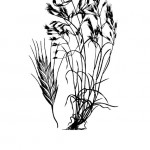Japanese Brome , Cheat Grass
Bromus japonicus
Poaceae
Description
Usually clump-forming, its stems are slender, tall, erect or spreading, and bent at the base. Stems have swollen, brown nodes and fuzzy sheaths, at least the lowermost has long, soft, retrorse hairs. Leaves, reaching up to 7 mm wide and 10 to 20 cm long, are both basal and on the stem. The longer leaves often twist from the base, so the bottom side is on top at the apex. The panicle of up to 8 inches or 20 cm is nodding, has two to six slender, wavy, and often kinked branches in whorls, and carries several flat, often hairy, spikelets at the end. The spikelets measure 10 to 15 mm with a distinct awn of 15 mm and have 6 to 11 florets. Japanese Brome is an annual, cool-season, introduced grass species reaching 2 ft or 60 cm. Its other common name, Cheat Grass, comes from landowners believing they had been cheated in their grass seed purchase by the inclusion of Japanese Brome seeds. Being among the first grasses to resume growth, its seeds mature in the spring at the very time native grasses are just starting to grow, so it can outcompete them. Japanese Brome is poor grazing for both livestock and wildlife.Habitat
Adapted to thrive in all soil types, Japanese Brome prefers moist areas. It grows in waste places, fields, along roadsides, and is an aggressive invader of pastures. Because it competes with native grasses for moisture and nutrients, it is considered a noxious weed. It is native to central and southeast Europe and central Russia.Images
Plant Characteristics
Duration: Annual
Stem Texture: Hairy
Growth Habit: Bunch grass, Grasses
Season: Cool
Distribution
 : 02 - Gulf Prairies and Marshes, 03 - Post Oak Savannah, 04 - Blackland Prairies, 05 - Cross Timbers and Prairies, 06 - South Texas Plains, 07 - Edwards Plateau, 08 - Rolling Plains, 09 - High Plains, 10 - Trans-Pecos
: 02 - Gulf Prairies and Marshes, 03 - Post Oak Savannah, 04 - Blackland Prairies, 05 - Cross Timbers and Prairies, 06 - South Texas Plains, 07 - Edwards Plateau, 08 - Rolling Plains, 09 - High Plains, 10 - Trans-Pecos
Distributions
Distribution refers to the ecological region in Texas that a plant has been found. You can also view a clickable map.
Book: Know Your Grasses (B-182)
Collection: Grasses


